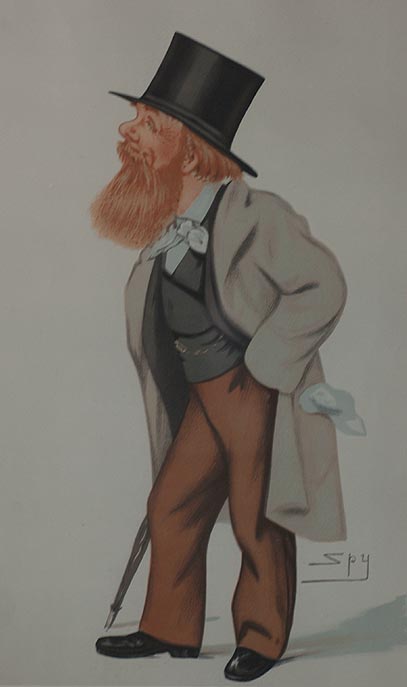
Sir Leslie Matthew Ward (21 November 1851–15 May 1922) was the highly perceptive caricaturist "Spy," a British artist who over forty years painted some 1,325 portraits which were regularly featured in the magazine Vanity Fair. He was born into an artistic family: his parents were Henrietta Ward and Edward Matthew Ward, but after leaving Eton he was articled to the architect Sydney Smirke, in an effort to place him in a more predictably rewarding career. Fortunately for posterity, the effort failed:
Leslie's reluctance to continue studying architecture led to a confrontation with his father in 1871 which was resolved through the intervention of W. P. Frith and Frith’s subsequent offer to apprentice the young Ward. Two years later another artist and friend of the family, John Millais, submitted some of Ward’s sketches to Thomas Gibson Bowles who, in early 1873, was searching for a caricaturist to replace Pellegrini after one of Pellegrini’s many departures. Bowles was favourably impressed with Ward’s work and hired him. On 1 March 1873, Leslie Ward’s first caricature, "Old Bones," Dr Richard Owen, zoologist and superintendent of the natural history department of the British Museum, appeared in Vanity Fair. Ward would be identified with the magazine for nearly forty years under the nom de crayon Spy, a name he and Bowles picked from the dictionary. [11]
The character studies began as sketches, which Ward then turned into portraits, and next into chromolithographs for publication in the magazine. Often these were reproduced on high quality paper and sold as fine-art prints. He so profoundly influenced the satirical genre that all the magazine's caricatures were referred to as "Spy cartoons," regardless of whether the artist was actually signing himself "Ape" (Carlo Pellegrini), "Singe," or "Drawl" (Ward again).



Left to right: (a) Sir John Everett Millais (drawing, 1874). (b) The Marquis of Salisbury (watercolour, 1902). (c) The Pre-Raphaelite of the world (lithograph, 1879).
Spy's early portraits intended for publication were almost always full-length, with the exception of judges on the bench; he originally made his subjects look rather cartoonish by emphasizing the caricatural elements of the face, and by distorting the proportions of the subject's upper body. He tended to exaggerate the size of the head and upper body, and to make the lower parts proportionately much smaller. However, in his mature period Ward took his subjects more seriously, and avoided offending his potential sitters, as his style developed into what Ward termed "characteristic portraits." Philip Allingham, with Jacqueline Banerjee">
Portraits
- The Artist's Great-grandfather and great-great-grandmother, in Old Age
- The Marquis of Salisbury 1902 (watercolour)
- John Everett Millais, R. A., drawing for The Graphic, 1874)
- My Sister, Beatrice (1874)
Some of Spy's Political and Artistic Celebrities from Vanity Fair
- The Queen's Sculptor [Joseph Edgar Boehm]
- The Serjeant (Sir John Simon 'Statesmen. No. 500.')
- Augustus Charles Hobart-Hampton (Hobart Pasha)
- Sir Robert William Edis
- Sir August Friedrich Manns
- He Painted 'The Doctor' [Sir Samuel Luke Fildes]
- Anthony Trollope, Novelist (Men of the Day No. 60) 5 April 1873
- Sir Benjamin Disraeli (Statesmen, No. 1) 30 January 1869
- "Tess" — Thomas Hardy, Novelist (4 June 1892)
- Prime Minister W. E. Gladstone
- The Novelist who invented Sensation [Wilkie Collins] 3 February 1872
- The Pre-Raphaelite of the world 19 July 1879
- John James Robert Manners, Seventh Duke of Rutland (1818-1906): The Making of a Statesmam
Links to Related Material
- Discussions of Caricature
- Punch, or the London Charivari
- Henrietta Ward (1832-1924): A Brief Biography
- Edward Matthew Ward (1816-1879)
Bibliography
Matthews, Roy, and Peter Mellini. Introduction. In "Vanity Fair". London: Scolar Press, 1982. 11-38.
Paleologu, Jean de '(PAL'). Sir Leslie Ward. Vanity Fair. 11 November 1889. NPG 3007. Watercolour, 1889. National Portrait Gallery, London. Web. 24 July 2023.
Vandyk, Carl. "Photograph of Sir Leslie Ward." (circa 1915) Frontispiece for Sir Leslie Ward's Forty Years of 'Spy'. London: Chatto and Windus, 1915.
Ward, Leslie ['Spy']. Forty Years of 'Spy'. London: Chatto and Windus, 1915.
Created 26 July 2023